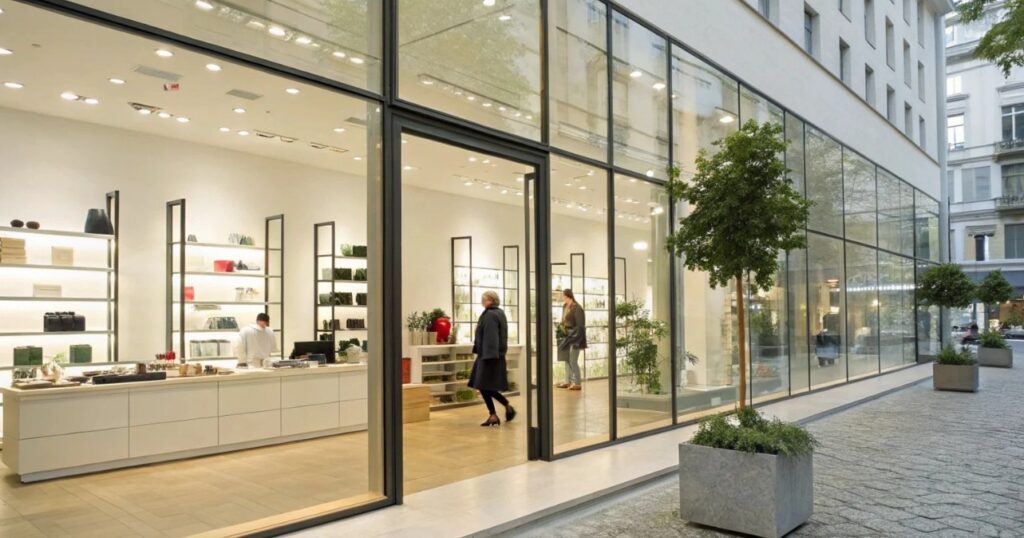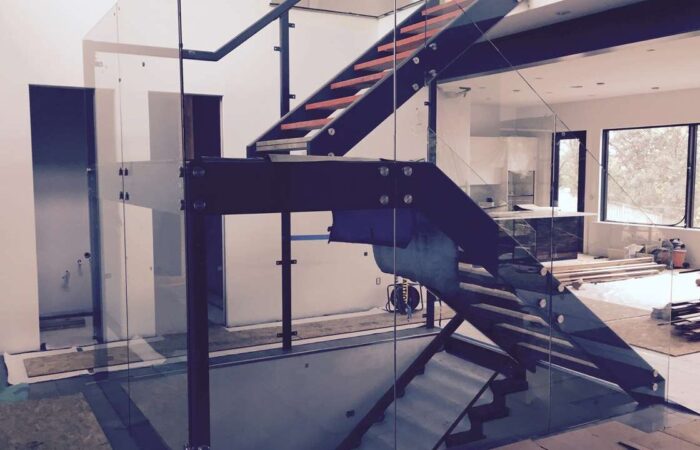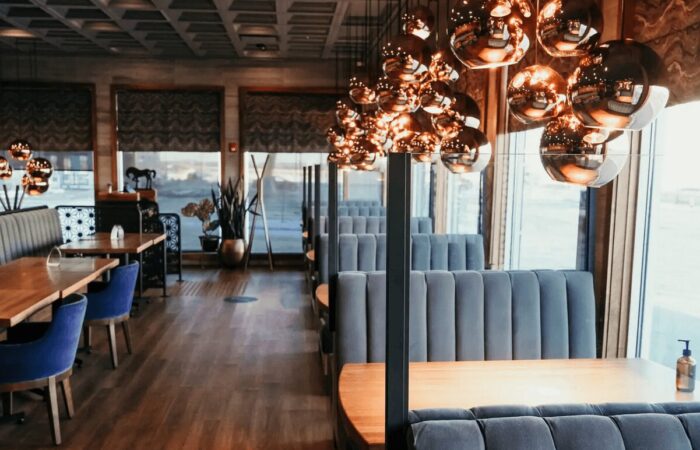
The retail landscape is evolving rapidly, and nowhere is this more evident than in storefront design. As we move into 2025, glass storefronts continue to dominate the commercial architecture scene, offering unparalleled opportunities for businesses to create compelling first impressions. In Alberta’s competitive retail environment, where foot traffic and visual appeal can make or break a business, understanding the latest glass storefront trends isn’t just beneficial—it’s essential for survival and growth.
Glass storefronts have transcended their traditional role as mere barriers between interior and exterior spaces. Today, they serve as dynamic marketing tools, architectural statements, and customer engagement platforms. The transparency, versatility, and modern aesthetic of glass make it the material of choice for retailers looking to create inviting, light-filled spaces that draw customers in from the street.
The Psychology of Glass in Retail Design
Modern consumers are drawn to transparency—both literally and figuratively. Glass storefronts tap into this psychological preference by creating an immediate sense of openness and trust. When potential customers can see into a retail space, they feel more comfortable approaching and entering, reducing the psychological barriers that solid walls or heavily tinted windows might create.
Research in environmental psychology suggests that natural light and visual connectivity to the outdoors significantly impact consumer behaviour. Glass storefronts maximize these benefits by:
- Creating a seamless visual flow between interior and exterior spaces
- Allowing natural light to illuminate merchandise and create an inviting atmosphere
- Enabling passersby to quickly assess the store’s offerings and ambiance
- Reducing the perceived risk of entering an unfamiliar retail space
The transparency of glass also allows retailers to showcase their products 24/7, turning their storefronts into continuous marketing displays even when the store is closed.
Studies conducted across major Canadian retail centers demonstrate that stores with well-designed glass storefronts experience up to 35% higher foot traffic compared to those with traditional solid facades. This psychological advantage becomes even more pronounced during Alberta’s long winter months, when bright, inviting storefronts provide a welcome contrast to the often grey and cold outdoor environment. The ability to create a warm, illuminated beacon that showcases interior warmth and activity can be the deciding factor in whether potential customers choose to venture out during harsh weather conditions.
Trend 1: Blurring the Boundary with Operable Glass Walls
In 2025, the most impactful trend for ground-level retail spaces is the move toward operable glass wall systems. These designs effectively blur the boundary between the interior and the street, fundamentally changing how customers interact with the store. Instead of being a solid barrier, the glass storefront becomes a flexible, retractable element that can transform the entire space on demand.
Benefits of utilizing operable glass walls include:
- Seamless Indoor-Outdoor Flow: During pleasant weather, the entire storefront can open, creating a flowing space perfect for cafés, boutiques, and lifestyle retailers.
- Enhanced Customer Engagement: An open facade removes the physical barrier, inviting customers directly into the retail environment rather than simply past it. This is invaluable for seasonal sales and sidewalk displays.
- Increased Perceived Space: For smaller retail spaces, opening the entire front wall dramatically increases the sense of openness and size.
- Flexible Retail Formats: The walls can be configured to partially open, creating a window-service area, or fully open for a complete al fresco experience.
This trend requires specialized structural engineering and hardware to ensure smooth operation and, critically, superior weather sealing to withstand sudden changes in Alberta’s climate. When closed, these walls must offer the same high thermal performance as fixed glass to maintain energy efficiency.
Trend 2: Oversized Glass Panels and Minimalist Framing
The trend toward larger glass panels with minimal framing continues to gain momentum in 2025. This approach maximizes transparency while creating a sleek, contemporary aesthetic that appeals to modern consumers.
Benefits of oversized glass panels include:
- Unobstructed Views: Larger panels reduce visual interruptions, creating clearer sightlines into retail spaces
- Enhanced Natural Light: Bigger glass surfaces allow more natural light to penetrate interior spaces
- Modern Aesthetic: Clean lines and minimal framing create a sophisticated, upscale appearance
- Flexible Display Options: Large, uninterrupted surfaces provide more opportunities for window displays and signage
The engineering challenges of supporting larger glass panels have been largely overcome through advances in structural glazing systems and high-strength glass manufacturing. Modern glazing techniques can support panels that seemed impossible just a few years ago, opening new possibilities for dramatic storefront designs.
Trend 3: Textured and Patterned Glass Applications
While transparency remains king, 2025 sees an increased interest in textured and patterned glass elements that add visual interest while maintaining the benefits of glass construction. These applications allow retailers to create unique brand identities while controlling visibility and light diffusion.
Popular textured glass options include:
- Frosted Glass Accents: Strategic use of frosted glass can create visual breaks, highlight specific areas, or provide subtle branding opportunities
- Geometric Patterns: Etched or sandblasted geometric patterns add visual interest without completely obscuring interior views
- Gradient Effects: Glass with gradient opacity creates dynamic visual effects that change throughout the day as lighting conditions shift
- Custom Brand Integration: Laser etching and digital printing technologies enable the integration of logos, patterns, or artistic elements directly into the glass
These applications are particularly effective in Alberta’s retail environments, where businesses need to stand out in competitive commercial districts while maintaining professional appearances.
Trend 4: Sustainable and Energy-Efficient Glass Solutions
Environmental consciousness continues to drive retail design decisions, and glass storefront specifications are no exception. Advanced glazing technologies now offer superior energy performance while maintaining the aesthetic and functional benefits that make glass attractive to retailers.
Key sustainable glass features for 2025 include:
- Triple-Pane Insulating Units: Enhanced thermal performance is crucial for Alberta’s extreme temperature variations
- Low-E Coatings: Selective light transmission that reduces heat gain in summer and heat loss in winter
- Gas Fills: Argon or krypton gas between panes improves insulation properties
- Recycled Content: Increased use of recycled glass materials in manufacturing
- Lifecycle Considerations: Designs that facilitate future recycling and component replacement
These features are particularly important in Alberta, where energy costs can significantly impact retail operations. The provincial government’s focus on energy efficiency also means that sustainable glazing choices may qualify for rebates or tax incentives.
Trend 5: Curved and Non-Linear Glass Designs
Architectural creativity is pushing beyond traditional rectangular glass panels toward curved and organically shaped glass elements. Advanced manufacturing techniques now make complex glass shapes more feasible and cost-effective for commercial applications.
Benefits of curved glass designs include:
- Distinctive Visual Identity: Unique shapes help retail spaces stand out in crowded commercial districts
- Improved Wind Resistance: Curved surfaces can better handle Alberta’s challenging weather conditions
- Enhanced Structural Performance: Properly designed curves can actually strengthen glass installations
- Creative Display Opportunities: Non-linear surfaces offer unique possibilities for product placement and visual merchandising
While more complex than traditional installations, curved glass elements can create memorable storefronts that significantly enhance brand recognition and customer attraction.
Trend 7: Advanced Tinting and Colour Technologies

The evolution of glass tinting technology has opened new possibilities for retailers seeking to balance transparency with brand identity and energy efficiency. Modern tinting solutions go far beyond basic sun protection, offering sophisticated colour options and performance characteristics that can transform the entire character of a retail space.
Contemporary tinting technologies include:
- Ceramic Tinting: Superior heat rejection without interfering with electronic signals or creating a mirrored appearance
- Spectrally Selective Films: Advanced coatings that block infrared heat while maintaining visible light transmission
- Decorative Colour Films: Branded colour applications that maintain professional appearance while supporting corporate identity
- Photochromic Options: Glass that automatically adjusts tint levels based on ambient light conditions
For Alberta retailers, these technologies offer particular value in managing the intense sunlight during summer months while preventing merchandise fading and reducing cooling costs. The ability to maintain clear visibility while controlling solar heat gain can significantly impact both customer comfort and operational expenses.
Safety and Security Considerations
Modern glass storefront design must balance aesthetic appeal with robust security features. Advanced glass technologies now offer enhanced protection without compromising the transparency and openness that make glass attractive to retailers.
Key security features include:
- Laminated Glass Construction: Multiple glass layers with interlayer films that hold fragments together if breakage occurs
- Impact-Resistant Options: Specially treated glass that can withstand significant force while maintaining structural integrity
- Smart Security Integration: Glass panels that can incorporate sensors, alarms, or monitoring systems
- Reinforced Mounting Systems: Structural supports designed to resist forced entry attempts
These features are particularly important for ground-level retail spaces in busy commercial districts, where security concerns must be balanced with the desire to maintain an open, welcoming appearance.
Trend 6: Integrated Lighting Systems
The boundary between glass and lighting continues to blur as LED technology becomes more sophisticated and energy-efficient. Integrated lighting systems transform glass storefronts into dynamic, attention-grabbing displays that can adapt to different times of day, seasons, or promotional needs.
Innovative lighting integration approaches include:
- Edge-Lit Glass Panels: LED strips around panel perimeters create even illumination across entire glass surfaces
- Embedded LED Systems: Thin LED films or strips integrated directly into laminated glass constructions
- Colour-Changing Capabilities: RGB LED systems that allow retailers to modify their storefront appearance for different occasions
- Smart Controls: Automated systems that adjust lighting based on ambient conditions, time of day, or customer traffic patterns
These systems are particularly valuable during Alberta’s long winter months when effective artificial lighting can compensate for reduced daylight hours and create inviting retail environments.
Climate Considerations for Alberta Retailers
Alberta’s unique climate presents both challenges and opportunities for glass storefront design. The province’s extreme temperature variations, from scorching summers to frigid winters, require careful consideration of thermal performance and structural integrity.
Critical climate factors include:
- Temperature Extremes: Glass systems must handle temperature swings of 60°C or more between seasonal extremes
- UV Exposure: High-altitude UV levels require protective coatings to prevent merchandise fading and maintain glass clarity
- Wind Loads: Prairie winds can create significant structural stresses that must be accounted for in design
- Ice and Snow: Proper drainage and heating systems prevent ice buildup that could damage glass installations
Modern glazing technologies address these challenges through improved insulating properties, structural engineering, and protective coatings specifically designed for harsh climates.
Additionally, Alberta’s unique position as a gateway to both mountain and prairie environments means that glass installations must accommodate diverse microclimates within relatively small geographic areas. Urban heat island effects in cities like Calgary and Edmonton can create temperature differentials that stress glass systems, while rural locations may experience more extreme wind conditions and temperature fluctuations. Professional glazing contractors familiar with these regional variations can specify appropriate glass grades and installation techniques to ensure optimal performance regardless of specific location within the province.
Future-Proofing Your Storefront Investment
As retail continues to evolve, glass storefront designs must anticipate future needs and technologies. Planning for adaptability ensures that current investments remain relevant and valuable as innovations emerge.
Forward-thinking design considerations include:
- Modular Systems: Glass installations that can be easily modified or expanded as business needs change
- Technology Integration: Infrastructure planning for future smart glass, sensors, or interactive display technologies
- Maintenance Access: Designs that facilitate easy cleaning, repair, and component replacement
- Code Compliance: Staying ahead of evolving building codes and accessibility requirements
The most successful retail spaces will be those that can adapt to changing consumer expectations and technological capabilities while maintaining their visual appeal and functional performance.
Cost-Benefit Analysis of Premium Glass Features
While advanced glass technologies and design features require higher initial investments, the long-term benefits often justify the costs through improved energy efficiency, increased foot traffic, and enhanced brand value.
Key financial considerations include:
- Energy Savings: High-performance glazing can reduce heating and cooling costs by 20-40%
- Increased Sales: Attractive storefronts can increase foot traffic and conversion rates
- Maintenance Costs: Quality glass installations require less frequent replacement and repair
- Brand Value: Professional, modern storefronts enhance perceived business value and credibility
ROI calculations should consider both direct cost savings and indirect benefits such as improved customer perception and competitive advantage in Alberta’s retail markets.
Installation and Maintenance Best Practices
Proper installation and ongoing maintenance are crucial for maximizing the performance and lifespan of glass storefront systems. Working with certified glaziers ensures that installations meet industry standards and local building codes.
Essential maintenance practices include:
- Regular Cleaning: Professional cleaning maintains appearance and prevents permanent staining
- Seal Inspection: Annual checks of weatherstripping and structural seals prevent air and water infiltration
- Hardware Maintenance: Lubrication and adjustment of moving parts ensure smooth operation
- Performance Monitoring: Tracking energy consumption and identifying efficiency changes over time
Establishing maintenance schedules from the outset protects the investment and ensures consistent performance throughout the life of the installation.
Conclusion
The glass storefront trends of 2025 represent a convergence of aesthetic appeal, technological innovation, and practical functionality. For Alberta retailers, these developments offer unprecedented opportunities to create compelling customer experiences while addressing the unique challenges of the province’s climate and competitive landscape.
Success in implementing these trends requires careful planning, professional expertise, and a clear understanding of how glass design can support broader business objectives. The retailers who invest in thoughtful, well-executed glass storefront designs will find themselves well-positioned to attract customers, reduce operating costs, and build lasting brand recognition in Alberta’s dynamic retail environment.
As the retail landscape continues to evolve, glass storefronts will undoubtedly play an increasingly important role in defining successful commercial spaces. The trends outlined here provide a roadmap for retailers looking to leverage the power of glass design to drive business success in 2025 and beyond.
Ready to transform your retail space with cutting-edge glass storefront design? Red Seal Glass brings certified expertise and innovative solutions, helping businesses create stunning storefronts that attract customers and drive sales. Our experienced glaziers understand the unique challenges of Alberta’s climate and can design custom glass solutions that combine aesthetic appeal with practical performance. Contact Red Seal Glass today to discover how the latest glass technologies can elevate your retail presence.

